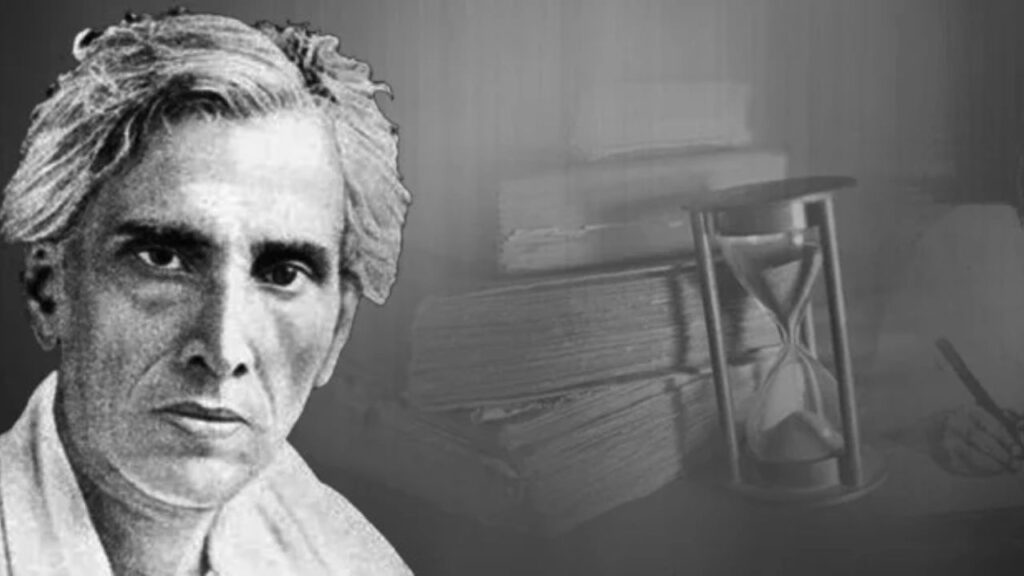Sarat Chandra Chattopadhyay Biography: Sarat Chandra Chattopadhyay was a Bengali novelist and short story writer who lived from September 15, 1876, to January 16, 1938. His name was also spelled Sarat Chandra Chatterjee and Saratchandra Chatterji. Most of the time, he wrote about Bengali families and culture in towns and cities.
Table of Contents
Sarat Chandra Chattopadhyay Biography:
| Name | Sarat Chandra Chattopadhyay |
| Nickname | None |
| Date of Birth | September 15, 1876 |
| Death | January 16, 1938 |
| Religion | Hindu |
| Birth Place | Debanandapur, West Bengal |
Sarat Chandra Chattopadhyay Wiki and Biography
Sarat Chandra Chattopadhyay writing can reach across barriers and connect with all Indians because he is very good at observing people, has a deep understanding of human psychology (including the “ways and thoughts and languages of women and children”), writes in a clear and natural way, and doesn’t have any political or social biases.
It is still true that he is the most translated and adopted Indian author of all time.
Sarat Chandra Chattopadhyay Early Life, Education and Childhood
In 1876, Sarat Chandra Chattopadhyay was born in Debanandapur, West Bengal. He came from a Bengali Brahmin family. Matilal, Bhubanmohini’s father, and Bhubanmohini, her mother, had two children. He was their oldest son and second child.
Though he was very poor, he was very interested in literature, which is why, at age seventeen, he started writing short tales.
Sarat Chandra went to school in Debanandapur and Bhagalpur. He did well on the entrance exam and was accepted into Tejnarayan Jubilee College.
He became interested in English writing and set up a literary society for kids in Bhagalpur. But because of money problems, he had to stop his official studies.
It was 1895 when Matilal’s wife died. He left the family home and sold his ancestral home to pay off his bills. Sarat Chandra played sports, hung out with friends, and was in shows. He wrote many well-known books, such as Bordidi, Chandranath, and Devdas.
After working at different jobs, Sarat Chandra left home as a sannyasin (monk) and went back to Calcutta to become an attorney. He went to Burma in 1903 and sent the story “Mandir” to the “Kuntaleen Story Competition.” It won first place out of 150 other stories that were sent in.
This story was released under the name of another uncle. It was Sarat Chandra’s first printed work, and he is 27 years old.
Also Read: Manoj Das Biography: Birthday, Wiki, Early Life, Education, Career, Awards, Personal Life
Sarat Chandra Chattopadhyay Career
Sarat Chandra lived and worked in Burma for thirteen years, doing a variety of jobs and meeting mistris, manual workers, engineers, craftsmen, and artists. Along with art, he read a lot.
His house burned down in 1912, and he lost everything in it, including his paintings and the rough draft of his book Choritrohin. When he started writing again in 1914, 18 years had passed since his last work.
He wrote a short story for the magazine Jamuna that got a lot of attention and made him famous. He quit his job because he was sick in 1916 and went to Calcutta.
As of 1916, Sarat Chandra Chattopadhyay lived in Howrah, which is like a twin city of Calcutta, and wrote full-time. His short stories and novels that were published in parts were in magazines like Jamuna, Bharatvarsha, and Narayan. Later, his novels and collections of short stories were released as books.
His books became very famous, and the royalties from them helped him get out of poverty for the first time in his life.
The book Biraj Bou was turned into a play in 1918 and put on at the famous Star Theatre. A piece by James Drummond Anderson in the Times Literary Supplement called “A New Bengali Writer” presented Sarat Chandra to people in the West.
Chandrashekhar Pathak translated his book Biraj Bou into Hindi in 1919. It was the first time that his work was translated into another Indian language.
This person, Sarat Chandra, was a strong supporter of the Indian freedom fight and the leader of the Indian National Congress branch in Howrah.
Besides Chittaranjan Das and Subhas Chandra Bose, he had a lot of other freedom fighters and political leaders as friends. The colonial British Government of India banned his book Pather Dabi (1926), which was very critical of the British Raj. This ban was lifted after Sarat Chandra’s death.
Sarat Chandra got a lot of praise for his work, but his formal education stopped in Class XII.
He was given the prestigious Jagattarini Gold Medal and a Doctor of Literature (honoris causa) by the University of Calcutta in 1923. Each of the winners has been made a knight.
Sarat Chandra lived in Burma for thirteen years and did a lot of reading and different jobs. After a break of about eighteen years, he started writing again in 1914. In 1916, he quit his job because he was sick and went to Calcutta.
Sarat Chandra Chattopadhyay Personal Life, Family, and Wife
He was born to Matilal Chattopadhyay and Bhubanmohini Devi, who was a gentle and hardworking woman.
The fact that most of the characters in his books are women shows how much his mother affected his mental health. Sarat was the second of seven children; five of them lived to adulthood. His mother was a Bengali mistri, and her father set up the marriage of his daughter to a drinker.
Two years after they got married, Sarat’s wife and son died of the plague. Sarat married Mokshada, his daughter who had lost her husband. At first, she didn’t want to, but in the end she agreed.
He changed her name to Hironmoyee and taught her to read and write. She lived 23 years longer than he did. They didn’t have any kids.
Also Read: Rajarshi Shahu Maharaj Biography: Wiki, Height, Early Life, Achievements, Wife, Death



